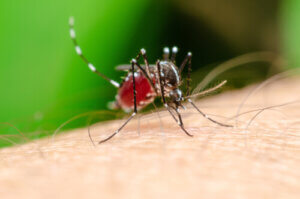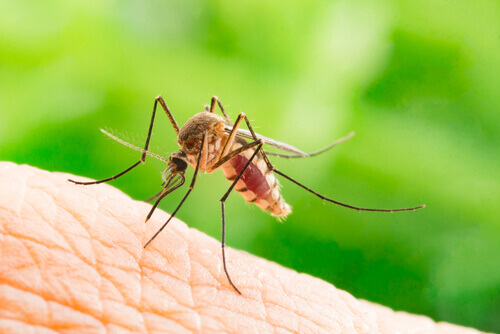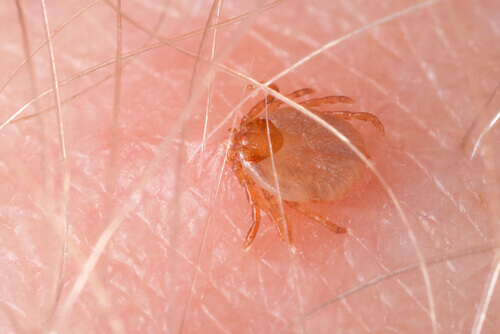Zoonotic Diseases and Insects


Written and verified by the biologist Samuel Sanchez
As summer arrives, lots of insects also come with it. Although we don’t like these bugs very much, they’re an important part of the fauna of our planet. In fact, mosquitoes and flies are essential pollinators. They are also a food source for many other animals. However, some of these insects are transmitters of zoonotic diseases through interaction with humans.
What are zoonotic diseases?
The term zoonosis refers to any infectious disease that is naturally transmitted from an animal to humans, or vice versa.
When a human is the transmitter, the correct term is actually anthropozoonosis.
We can all think of some diseases that have been talked about a lot in the media, caused by livestock or other agricultural species. For example, you’ve probably heard of avian flu, swine flu, or mad cow disease. Still, there are much smaller animals that go unnoticed that are capable of transmitting diseases to humans. In fact, these diseases are often more dangerous.
Now, let’s take a look at various disease-producing insects, recognized by the World Health Organization.
The yellow fever mosquito
The yellow fever mosquito or dengue mosquito (Aedes aegypti), as the name suggests, is responsible for diseases such as dengue, yellow fever, or Zika.
This small arthropod is distinguished by its striking white bands. However, this morphology is usually not distinctive enough to differentiate them from other mosquitoes of the Aedes genus.
As you might already know, only female mosquitoes feed on blood. This atypical behavior has a clear biological reason:
- Both males and females also feed on nectar, so both can live a full life cycle without biting vertebrates.
- Even so, females require blood to obtain the nutrients necessary to lay eggs.
- Females that don’t consume blood won’t be able to give birth to offspring.
Unlike other mosquitoes, Aedes aegypti is more active during the day than at night. This increases the probability that they will come into contact with more humans.
In 2013, there were 2.3 million cases (430.8 per 100,000) and 1,280 deaths in the Americas from dengue.

Sandflies and zoonotic diseases
Now, let’s look at another winged animal, namely the various species of the genus Phlebotomus. Sandflies are transmitters of the leishmaniasis disease.
These insects are similar to common mosquitoes but are much smaller. They measure two to three millimeters at the most. Their bodies are also semi-transparent and covered in hair.
- Similar to mosquitoes, both males and females feed on plant nectar or aphid secretions.
- Females only need to feed on blood to produce eggs.
The protozoan Leishmania is transmitted by the saliva of the female mosquito as they bite another animal. This disease can then infect rodents, dogs, marsupials, and primates.
Doctors diagnosis an average of 60,000 cases of cutaneous and mucosal leishmaniasis and 4,000 cases of visceral leishmaniasis each year in North and South America, with a mortality rate of 7%.
Ticks
On the other hand, not all zoonotic disease-transmitting arthropods can fly. One example of this is ticks. While they’re not technically insects (they belong to the class of arachnids), they deserve a special mention:
- The Ixodes ricinus tick can exceed one centimeter in length after ingesting blood from a host and transmits a wide variety of diseases to various vertebrates. In fact, they’re transmitters of the Borrelia bacteria, which is the cause of Lyme disease.
- The Hyalomma marginatum tick is the main vector of the Crimean Congo hemorrhagic fever virus.
However, it’s more difficult for ticks to access human beings. For example, these arachnids can’t fly so they hang on to plants, waiting to jump on to unfortunate hosts. This means that there’s an increased risk for people who live in rural settings or those who are in contact with wild mammals.

Important to the ecosystem, but with a cost
In general, arthropods are essential to the functioning of any ecosystem. As we mentioned previously, they are the main pollinators, which allows flora to grow. In addition, they also are a source of nutrients for many different species.
Even if they are threats to humans as transmitters of zoonotic diseases, it’s always important to remember that every living being deserves respect and admiration whenever they are in their natural environment.
All cited sources were thoroughly reviewed by our team to ensure their quality, reliability, currency, and validity. The bibliography of this article was considered reliable and of academic or scientific accuracy.
- Aedes aegypti, Wikipedia. Recogido a 31 de mayo en https://es.wikipedia.org/wiki/Aedes_aegypti.
- 10 enfermedades transmitidas por vectores que ponen en riesgo la población de las américas, OMS. Recogido a 31 de mayo en https://www.paho.org/hq/index.php?option=com_content&view=article&id=9438:2014-10-vector-borne-diseases-that-put-population-americas-at-risk&Itemid=135&lang=es
- Vectores pequeños, grandes problemas, ISglobal. Recogido a 31 de mayo en https://www.isglobal.org/healthisglobal/-/custom-blog-portlet/garrapatas-vectores-pequenos-grandes-problem-1/1584909/0.
This text is provided for informational purposes only and does not replace consultation with a professional. If in doubt, consult your specialist.